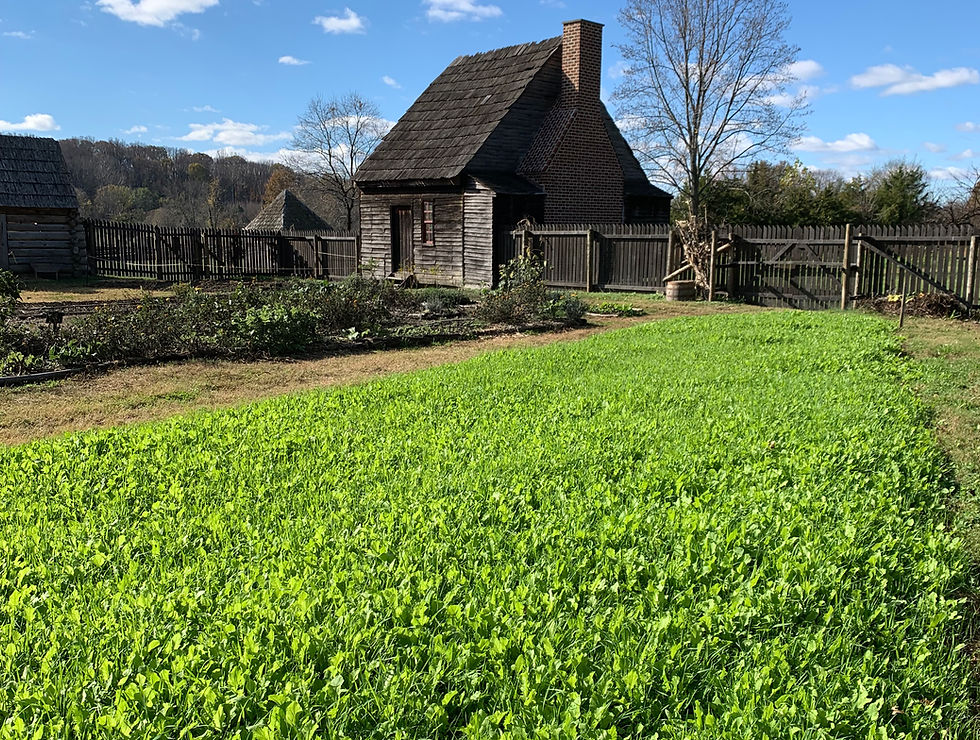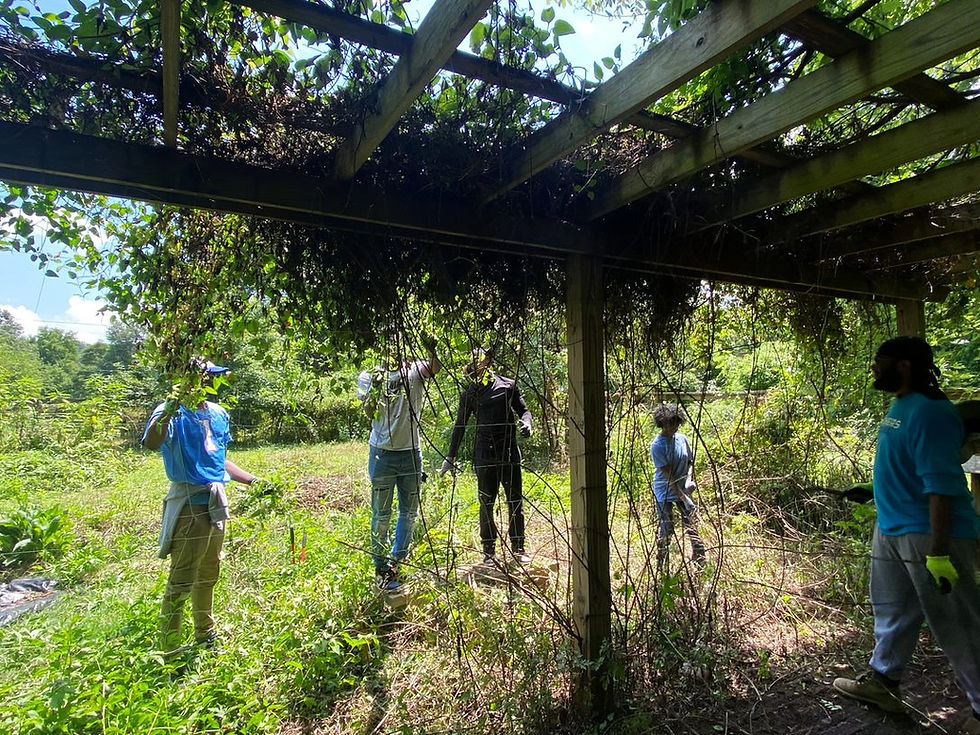Field Notes: Volume 16, Number 23
- Accokeek Foundation

- Oct 21, 2011
- 5 min read

This Week’s Harvest
Basil
Garlic
Arugula
Mizuna
Scallions
Fennel
Lettuce
Sweet Bell Peppers
By Courtney Buchholtz
Another week has passed and here I sit again staring at the blank screen of the computer, coaxing the words to fill the page in front of me. Why do I find writing so hard at times, most times? Perhaps it’s the expectations I place upon myself to write something that is beyond extraordinary, something that will capture you, take you out of your world and into ours. Or at least write something that makes you stop and think for a moment about your place in all this. For there are many days when I hardly see another soul and I feel rather detached from the rest of the world. So how do we give you a glimpse of the beauty that surrounds us daily? Words are one of the few options we have, so it’s words we choose.
The light rains this week brought a noticeable cooling of the air. And the winds took many of the leaves that had yet to change color from the trees, robbing us of the color we had only begun to start seeing. Not that the colors were going to be spectacular; drought followed by heavy rains doesn’t often make for wonderful fall colors. The grass dried out enough to mow and the fall clean-up has begun, which I like to think of as putting the garden to bed. Cover crops have been planted in the New Field and with Wednesday’s rains will hopefully start to germinate over the weekend. Though it’s later than we would normally plant cover crops—there is less daylight than we would like, and geese that come in and eat the young, fresh shoots—we opted to try anyway, knowing that the ground prefers to be covered versus bare and exposed. Our newest adaptation at the farm this week is our method of cultivation. With the ground too wet to use any traditional forms of cultivation, I have taken to using the weed whip as my primary choice in knocking back any weeds that threaten to go to seed. While the noise and vibration are less than ideal, I have at least succeeded in my intentions.
What remains of the crops are hanging on, and according to the weather, it appears as though there is little chance for rain over the next week and a half. But that is always subject to change, despite the weatherman’s best intentions. The sunrise on Tuesday morning was magnificent. Various shades of pink swirled about the sky and greeted me warmly as I stood at the kitchen window preparing for the day. These are the moments that remind me how lucky I am to be here, and to take the time to stop and just observe, to enjoy such wonder that is never the same from day to day. We anticipate having boxes for two more weeks following this one, and will keep you posted should anything change.
Since many of you have been asking, lately, about the greens in the boxes, I thought I would take some time to tell you a little more about mizuna and arugula (my personal favorite). Mizuna, also known by the names Xiu Cai, Kyona, Japanese Mustard, Potherb Mustard, Japanese Greens, California Peppergrass, and Spider Mustard, has a piquant, mild peppery flavor and is slightly spicy, but less so than arugula. Thought to have originated in China, mizuna is highly resistant to cold weather and produces an abundance of leaves that can be continually harvested over the course of many months. Often used in soups, stir fries, and other vegetable dishes, mizuna also makes a wonderful salad with great flavor and texture.
Arugula, also known as rocket, is a native to the Mediterranean, hailing from the region encompassing Morocco, Portugal, Lebanon, and Turkey. It has a rich, peppery taste, and an exceptionally strong flavor for a leafy green. High in potassium and vitamin C, it is generally used in salads, and often mixed with other greens in a mesclun mix. It is also cooked as a vegetable or used raw with pasta or meats in northern Italy and in western Slovenia (especially in the Slovenian Istria). In Italy, rocket is often used in pizzas, added just before the baking period ends or immediately afterward so that it will not wilt in the heat. In the Slovenian Littoral, it is often combined with boiled potatoes or used to make a soup. On the island Ischia in the Gulf of Naples, a digestive alcohol called rucolino is made from the plant, a drink often enjoyed in small quantities following a meal. The liquor is a local specialty enjoyed in the same way as a limoncello or grappa and has a sweet peppery taste that washes down easily. In Brazil, arugula is eaten raw in salads with dressing. A popular combination is arugula mixed with Mozzarella cheese (often made out of buffalo dairy) and sun-dried tomato, and maybe a splash of olives if you’d like!
—Your Farmers
Below, photos from this week on the Ecosystem Farm. Click images to enlarge, or view them on Flickr.
This Week’s Recipe: Arugula and Baby Greens with Sausage and Fennel
Ingredients:
4 sweet or spicy Italian sausages
4 cups baby arugula leaves
4 cups mixed baby greens
1 medium fennel bulb, tops trimmed, bulbs cored and thinly sliced
3 tablespoons chopped fresh chives
3 tablespoons olive oil
1 1/2 tablespoons balsamic vinegar
salt and pepper, to taste
Parmesan cheese shavings
Directions:
Saute sausage in a large, heavy skillet over medium heat until well-browned and cooked through, about 15 minutes. Slice sausage on the diagonal into 1/2-inch thick slices.
Combine arugula, mixed greens, fennel, and chives in a large bowl. Whisk olive oil and vinegar in a small bowl until blended and slightly thickened; season generously with salt and pepper. Toss arugula and greens with dressing. Top salad with Parmesan shavings and sausage and serve.
Hint: Don’t discard the tops trimmed from the fennel bulb! Roughly chop the bright green, aromatic fronds and add them to salads or wilted greens.
Upcoming Events
Twilight Tales: Saturday, October 29, 2011, 6 to 9 p.m., Accokeek Foundation Visitor Center: When night descends on the Potomac River, this historic site comes alive with spirits from Maryland’s past. From 6 to 7 p.m., visitors can enjoy scary stories and songs performed as the sun sets across the river. From 7 to 9 p.m., brave able-bodied souls may venture out to explore the haunted farm house. Then, follow a mysterious guide by lantern light through the fields to the Tobacco House and meet criminals and other lost souls from Colonial Maryland. This scary journey is appropriate for ages 8 and up.
Sustainable Table Potluck: Tuesday, November 8, 2011, 6 to 7:30 p.m., Education Center: It’s one thing to purchase produce that’s in season, and quite another to cook it. Sustainable Table is a monthly cooking course that demonstrates how to use in-season fruits, vegetables, and herbs to create healthful, wholesome, and delicious meals. To celebrate the end of the season, we invite our guests to join us for a potluck. Guests are encouraged to use seasonal ingredients—this month, think sweet potatoes, winter squash, apples, greens, and more—to make a soup, side, salad, or dessert to share. Please RSVP by clicking the link available here.







